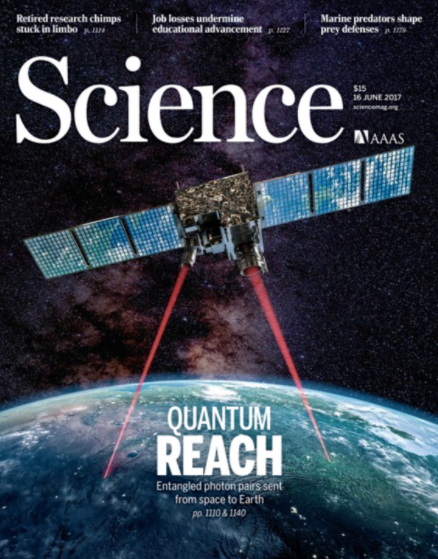In a few hours, the Nobel Prize in Physics will be announced. Here I will make a small prophecy. I think this year’s Nobel Prize goes to Aspect, Clauser and Zeikinger for their contribution to Bell Inequality verification – their work is really important. Their work declared to Einstein – sorry Mr Einstein, you are really wrong when it comes to quantum mechanics!
Although Einstein put forward the concept of “light quantum” and fired the starting gun of the quantum mechanics revolution; but he did not support the Copenhagen School’s interpretation of quantum mechanics founded by Bohr, so he has been looking for loopholes in the Copenhagen School’s theory. In the Copenhagen School’s interpretation of quantum mechanics, there is a strange thing called the uncertainty relation. According to the uncertainty relationship, the position and momentum of a microscopic particle cannot be accurately determined at the same time. If the particle’s momentum is accurately determined, the position is completely indeterminable; and if the position is accurately determined, the momentum is completely indeterminable. This time, Einstein attacked the relationship of uncertainty.
 uncertainty relationship
uncertainty relationship
In the paper titled “Can Quantum Mechanics’ Description of Physical Reality Be Considered Complete? ” paper, Einstein, Podolsky and Rosen (E, P, R, respectively) designed the famous EPR thought experiment – it is this thought experiment that opened the door to quantum communication for us :
 Einstein’s EPR paper
Einstein’s EPR paper
For example, there are now two interacting particles A/B, which move in two directions after they separate. Since there is no external force, the momentum of these two particles is conserved. When the two particles are far enough away, I can accurately measure the momentum pA of the A particle, and due to the conservation of momentum, pB=-pA; at this time, Einstein assumed that since the two particles are far enough, for A’s The measurement does not interfere with B (local theory), so if we accurately measure the position xB of the B particle at the same time, then we can accurately obtain the position and momentum of the B particle at the same time, which violates the uncertainty relationship. Here, Einstein made the assumption of local theory, that is, when the A/B particles are infinitely far apart, the observation of one particle will not have any effect on the state of the other particle.
This question attracted great attention from Bohr, who put down almost all his work to think about it. Five months later, in the same journal, Bohr published a response, even tit-for-tat with the exact same title – “Can Quantum Mechanics’ Description of Physical Reality Be Considered Complete?” “.
 Bohr’s rebuttal essay
Bohr’s rebuttal essay
In general, Bohr refuted the EPR paradox from three aspects.
1. Reiterated the meaning of “physical reality”, that is, only what is observed can be said to be physically true;
2. Explain that the observation must have an impact on other variables of the system (if the two variables are not commutable);
3. It shows that even if two particles are infinitely far apart, the observation of one particle will affect the state of the other particle – that is, the theory of localization does not hold.
Einstein was not satisfied with Bohr’s explanation, especially point 3. Intuition tells us that both particles are infinitely far away, and a measurement of one particle affects the other? Could this be an over-the-top effect? But until Einstein’s death, no one could find a proof method to verify whether the local theory is true, so it is impossible to prove what is right and what is wrong.
Scientist John Bell agreed with Einstein. Under his positive thinking, he proposed Bell’s inequality, which can be verified by experiments to prove whether it is Einstein’s pair or Bohr’s pair. His original intention was to prove that Einstein was right. As a result, it was never expected that, through experiments by Aspect, Clauser, Zeikinger and others, this inequality just proved that Einstein was wrong and Bohr was right. But unfortunately, John Bell has passed away and cannot win the Nobel Prize.
At the beginning, many Einstein supporters continued to talk hard – they tried their best to find all possible loopholes. Finally, in the Big Bell Test in 2016, all these possible loopholes were closed – Bohr’s idea, although not intuitive, was correct. In the Big Bell Experiment, more than 100,000 players were gathered around the world to play the game – maybe some of the readers of this article participated.
So what is the significance of such a proof? On the one hand, this has great significance for the theoretical basis of quantum mechanics. On the other hand, you may have heard that Academician Pan Jianwei of my country has successively made pioneering achievements in the field of quantum communication. Compared with traditional communication methods, quantum communication cannot be monitored and information cannot be stolen, which is a truly secure communication method. And it is because Bohr was right that quantum communication is possible.
 Academician Pan Jianwei’s paper on quantum communication was published in the journal “Science”
Academician Pan Jianwei’s paper on quantum communication was published in the journal “Science”
 Quantum entanglement
Quantum entanglement
Source: Zhihu www.zhihu.com
Author: Phosphates
[Zhihu Daily] The choice of tens of millions of users, to be a big cow to share new things in the circle of friends.
click to download
This article is reproduced from: http://zhuanlan.zhihu.com/p/570522549?utm_campaign=rss&utm_medium=rss&utm_source=rss&utm_content=title
This site is for inclusion only, and the copyright belongs to the original author.